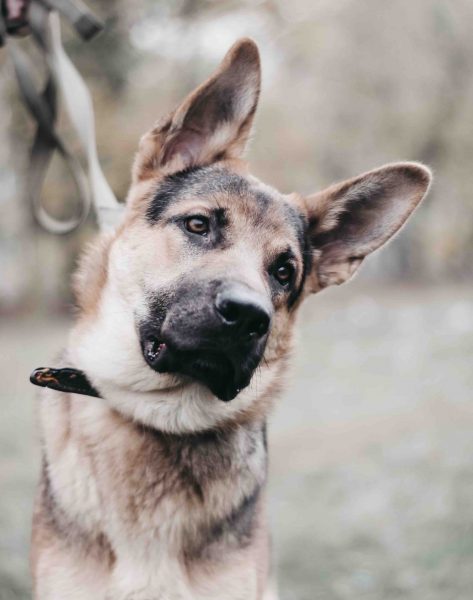What’s Your Dog’s Super Power Talent?

Does your Beagle ignore you because he’s too busy sniffing EVERYTHING? Does your German Shepherd bark at everyone you see? Are your kids tired of your Border Collie chasing them every time they are in the yard together? Did you know your dog is just making good use of his natural talents?
These are behaviors some of my recent clients have called me in to “fix”. The problem? These dogs are doing what they are hard-wired to do! Dogs have been selectively bred for skills and characteristics for MUCH longer than they’ve been bred to look a certain way (which is how all three dogs were chosen.)
Those skills are a part of who our dog IS, and what he is driven to DO. Our lack of understanding can lead to loads of frustration and stress, for us AND for our dogs.
What would life look like if we stopped struggling against our dogs’ natural talents, and thought of them as super-powers instead?
Nose
Is your dog a “nose” dog? (If he is, I’m sure you know it, and you’re nodding hard right now!)
All dogs have extraordinary noses, and we keep learning even more about them. There have been several recent publications focusing just on this extraordinary part of a dog. A dog’s nose has an average of 220 MILLION scent receptors (compared to our 3-5 million), and uses up to 1/4 of its brain capacity. Dogs can tell where a scent comes from, and they can discern every component of that scent (and in what measure.) They can even tell when that scent got there.
If your dog is one of the types bred specifically for their nose-skill, chances are they’re really good at what they do. To them, we must seem like absolute idiots. Think of how distracting the smell of a grilling steak, or freshly brewed coffee, can be to us. Is it a wonder dogs can be hard to refocus when they’re busy smelling something?

Eyes & Ears
Dogs’ eyes and ears are also perfectly suited to dogs’ needs. They’re part of an “early warning system” that keeps dogs (and their attached humans) safe, and gives them a leg up as predators.
While dogs’ eyes don’t seem to distinguish detail in the same way ours do, they have a much wider range of peripheral vision, and can see 60% of UV light, allowing them to see a “heat map”.
Although their ears’ internal structure is similar to ours, they can hear at 4 times lower levels than we can, and much farther away.
When you’re out with your dog and he perks up even though you don’t see or hear anything, BELIEVE HIM!
Now that you understand a little more about some of the “hardware” that makes our dogs able to do what they do, consider the combinations of traits your dog, his parents, his grandparents, and so on, may have been bred for.
- A scent hound is what he is because, at some point, people decided a dog who would follow a scent to the exclusion of all else, was a desirable thing.
- A dog whose head and ear shape are suited to favor eye and ear power, plus an alert and suspicious mind, made for a good guarder/tender.
- A dog whose eyes and nose, agile frame, and quick mind, allow it to move groups of other animals, was more helpful to someone than a dog that did not have that combination of skills.
These dogs we keep as pets are sometimes “right off the farm”, sometimes generations out, but their natural tendencies and biological imperatives have not gone away simply because of a change in scenery. We sometimes spend our dogs’ lives trying to control the hard wiring, to fit that square peg of a dog into the round hole of our poor fit of a lifestyle.
HOW FRUSTRATING!!!
Let me invite you
to get creative when it comes to allowing your dog to shine! While you don’t need to start her on a new career as a search and rescue dog, some nose-centric games and activities can fulfill a dog’s need to DO in that department.
If your dog loves to use his mouth (thinking of all my retriever friends here, as well as many of the herding and tending dogs,) give him tasks (carrying things) or games–with rules– (fetch, frisbee, flyball) that allow him to use his talent.
TRY THIS: Find a safe place!!! Spend an hour following your dog…see what interests her, notice what she notices. Enjoy spending time TOGETHER, without all the leash nagging (and name repeating.) Get in touch and in tune with her, and you’ll very likely notice her appreciation of that cooperation.
You’re probably getting some ideas of what might work for you, now get out there and spend some time with your dog! Drop a comment below and let me know what you’re excited to try!
Need help with your dog in Anne Arundel County, MD? Please fill out a contact form (CLICK HERE) and book your free phone consultation.
